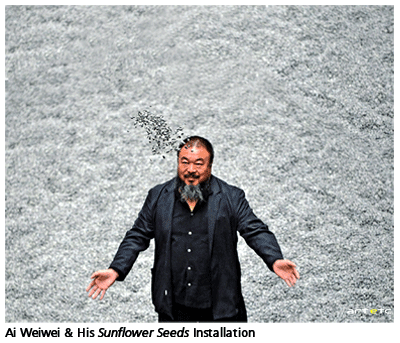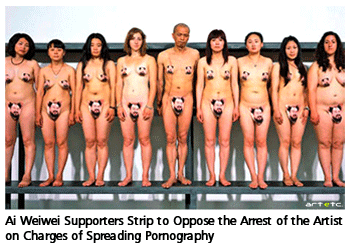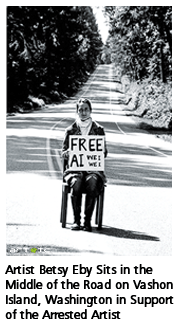- Publisher's Note
- Editorial
- Guerrilla Girls: The Masked Culture Jammers of the Art World
- Creating for Change: Creative Transformations in Willie Bester’s Art
- Radioactivists -The Mass Protest Through the Lens
- Broot Force
- Reza Aramesh: Action X, Denouncing!
- Revisiting Art Against Terrorism
- Outlining the Language of Dissent
- In the Summer of 1947
- Mapping the Conscience...
- 40s and Now: The Legacy of Protest in the Art of Bengal
- Two Poems
- The 'Best' Beast
- May 1968
- Transgressive Art as a Form of Protest
- Protest Art in China
- Provoke and Provoked: Ai Weiwei
- Personalities and Protest Art
- Occupy, Decolonize, Liberate, Unoccupy: Day 187
- Art Cries Out: The Website and Implications of Protest Art Across the World
- Reflections in the Magic Mirror: Andy Warhol and the American Dream
- Helmut Herzfeld: Photomontage Speaking the Language of Protests!
- When Protest Erupts into Imagery
- Ramkinkar Baij: An Indian Modernist from Bengal Revisited
- Searching and Finding Newer Frontiers
- Violence-Double Spread: From Private to the Public to the 'Life Systems'
- The Virasat-e-Khalsa: An Experiential Space
- Emile Gallé and Art Nouveau Glass
- Lekha Poddar: The Lady of the Arts
- CrossOver: Indo-Bangladesh Artists' Residency & Exhibition
- Interpreting Tagore
- Fu Baoshi Retrospective at The Metropolitan Museum of Art
- Random Strokes
- Sense and Sensibility
- Dragons Versus Snow Leopards
- What Happened and What's Forthcoming
- Art Events Kolkata, February – March 2012
- Mumbai Art Sighting
- Art Bengaluru
- Delhi Dias
- Musings from Chennai
- Preview, March, 2012 – April, 2012
- In the News, March 2012
- Cover
ART news & views
Provoke and Provoked: Ai Weiwei
Issue No: 27 Month: 4 Year: 2012
By Snehal Tambulwadikar
All art is political in the sense that all art takes place in the public arena and engages with an already existing ideology. Yet there are times when art becomes dangerously political for both the artist and the viewers who engage with that art. Think of Jacques-Louis David's involvement in the French Revolution. His individual comment on the French revolution following the bloodshed and his imprisonment during the reign of terror. If it were not for certain sympathisers, David may well have ended up another victim of the guillotine. Goya is another example of an artist who fell afoul of government power. There are instances in the 20th century when artists have faced down political power directly. Consider the photomontages of John Heartfield. Heartfield risked his life at times to produce covers for the magazine A/Z, which defied both Hitler and the Nazi Party. Art and protest are parallel, every movement in art has been a protest, every artist is commenting over/overtly in his own parameters. The Chinese artist, Ai Weiwei, offers an important contemporary example. Recently, Weiwei was arrested in China following a crackdown by the government on so-called “political dissidents” (a specific category that the Chinese government uses to classify those who seek to subvert state power) for “alleged economic crimes” against the Chinese state. Weiwei has used his art to address both the corruption of the Chinese communist government and its outright neglect of human rights, particularly in the realm of the freedom of speech and thought. Ai Weiwei, the exuberant Chinese artist is a national emblem for youth, an internationally acclaimed artist; an indefinitely aggressive person, an architect, designer, sculptor, 'blogger' and so on. Ai Weiwei (born in 1957), is today one of the China's most internally acclaimed artist, as was seen after the support he assumed after his detention in 2011.
Ai Weiwei has used the elements which were essentially scorned in his country, the internet, likes of Twitter, Facebook and blogging to reach out to mass, and involve mass back. He protests by igniting the like minds, my making a community individual, as China is in making. He uses community against the communism. The art and persona of Ai is a witness to the fuming rage of Chinese common, as he provocatively marches ahead.
China, with its sudden economic high, its rapidly developing international market, was making waves, but the complete control of the government over every action of the citizens was left to be emitted through silent ruptures. Ai comes out to be the gushing wave in the scene and thus scorned by the Chinese government. Ai Weiwei's father was Chinese poet Ai Qing, who was denounced during the Anti-Rightist Movement and in 1958 sent to a labour camp in Xinjiang with his wife, Gao Ying. Ai Weiwei was one year old at the time and lived in Shihezi for 16 years. In 1975 the family returned to Beijing. Ai Weiwei's already politically saturated childhood was infused with madness of the Cultural Revolution. Instead of studying the regular subjects, students split their time between working the fields and reading Mao Zedong's little red book. The 'dictatorship of the proletariat' might have been over their heads, but his generation was instilled with sympathy for masses and a social utopianism that is still reflected in Ai's practice.
In 1978, Ai enrolled in the Beijing Film Academy and attended school with Chinese directors Chen Kaige and Zhang Yimou. In 1978, he was one of the founders of the early avant garde art group the "Stars", together with Ma Desheng, Wang Keping, Huang Rui, Li Shuang, Zhong Acheng and Qu Leilei. The group disbanded in 1983, yet Ai participated in regular Stars group shows, The Stars: Ten Years, 1989 (Hanart Gallery, Hong-Hong and Taipei), and a retrospective exhibition in Beijing in 2007:Origin Point (Today Art Museum, Beijing).
From 1981 to 1993, he lived in the United States, mostly in New York, creating conceptual art by altering readymade objects. He studied at Parsons School of Design (which he never completed) and at the Art Students League of New York. Ai then couldn't avoid being affected by the traumatic events in Tiananmen Square June 4, 1989; shortly after which he endured an eight day hunger strike with a group called Solidarity for China. Here he came across the works of Michel Duchamp and Andy Warhol, whom he has always admired till date. Ai uses a lot of elements from that of Duchamp, such as usage of readymade material and a repetition of the same, commenting on the popular culture. In 1993, Ai returned to China after his father became ill. He helped establish the experimental artists' Beijing East Village and published a series of three books about this new generation of artists: Black Cover Book (1994), White Cover Book (1995), and Gray Cover Book (1997).
The notorious show Ai co-curated with Fong Boyi proved to be a critical movement in his international career. As a peripheral exhibition to the 2000 Shanghai Biennale, more than forty avant-garde artists were included in a show entitled Fuck off (the Chinese subtitle read Ways to Not Cooperate). It taunted the authorities to shut it down, with artworks that included allegedly poisonous gases and acts of cannibalism.
To promote the launch of its new blog Platform, Sina.com (in 2005) had invited various celebrity bloggers, Ai Weiwei among them, to open blogs that would be highlighted on the homepage. Just before that Ai had no contact with internet, but he was interested in exploring his literary talents. He began spending hours blogging each day, discovering the digital platform a place to divulge his life through photos. As Ai explored the connective potential of the Net, experimenting with how much digital information could be circulated. It soon provided inspiration for Fairytale, an epic-scale artwork that was facilitated over the net. Through his blog he invited applicants to participate in a mass movement performance piece that would bring 1001 Chinese citizens from all walks of life to Kassel, Germany, for Documenta 12. Fairytale would be the largest scale performance piece ever created, an incorporal labyrinth if interpersonal and cultural interactions whose effects would multiply exponentially and ripple through all layers of society. In it he surmounted all traditional frameworks for local and international art hierarchies, directly harnessing the power called the 'masses'.
 On March 20, 2009, Ai posted an invitation for volunteers to join a collective effort that would pressure the Sichuan Government to take responsibility for the Shoddy quality of the school buildings that has collapsed during the Wenchuan Earthquake resulting in death of thousands of school children, which he called Citizen Investigation. The Citizen Investigation produced a list of names, with the date of birth, school, grade, and parent/guardian contact number for more than five thousand children (the list numbers 5,210 in August 2010). Major solo show at Tokyo's Mori Art Museum and Munich's Hans der Kunst echoed what Ai said was the most lasting images of his visit to the quake- children's backpacks lying in rubble, on the ceiling of Museum, purpose-built black and white snaked in a coil; at Munich's Haus der Kunst (2009), backpacks in bright primary colours spelled out in museum's entire facade a quote in Chinese from the mother of a victim, 'she lived happily in this world for seven years'. Ai, who not only suffered mentally, but was also physically assaulted in the process.
On March 20, 2009, Ai posted an invitation for volunteers to join a collective effort that would pressure the Sichuan Government to take responsibility for the Shoddy quality of the school buildings that has collapsed during the Wenchuan Earthquake resulting in death of thousands of school children, which he called Citizen Investigation. The Citizen Investigation produced a list of names, with the date of birth, school, grade, and parent/guardian contact number for more than five thousand children (the list numbers 5,210 in August 2010). Major solo show at Tokyo's Mori Art Museum and Munich's Hans der Kunst echoed what Ai said was the most lasting images of his visit to the quake- children's backpacks lying in rubble, on the ceiling of Museum, purpose-built black and white snaked in a coil; at Munich's Haus der Kunst (2009), backpacks in bright primary colours spelled out in museum's entire facade a quote in Chinese from the mother of a victim, 'she lived happily in this world for seven years'. Ai, who not only suffered mentally, but was also physically assaulted in the process.
 Ai's work, the Sunflower Seeds (2010) which are in the Tate Modern Collection is an exquisite example of the Warholian idea of repetition, numerous things being exactly the same, because more you look at the same exact thing, the more meaning goes away, and the better and emptier you feel; like that of Chinese society today, after the mass production and the collective labour. The work consists of millions of individually crafted porcelain seeds scattered on the floor. Ai wanted people to walk, stroll and lie over the seeds and feel them, symbol of the mass production and community labour, using the idea of repetition and mass.
Ai's work, the Sunflower Seeds (2010) which are in the Tate Modern Collection is an exquisite example of the Warholian idea of repetition, numerous things being exactly the same, because more you look at the same exact thing, the more meaning goes away, and the better and emptier you feel; like that of Chinese society today, after the mass production and the collective labour. The work consists of millions of individually crafted porcelain seeds scattered on the floor. Ai wanted people to walk, stroll and lie over the seeds and feel them, symbol of the mass production and community labour, using the idea of repetition and mass.
On 24 February, amid an online campaign for Middle East-style protests in major Chinese cities by overseas dissidents, Ai posted on his Twitter account, I didn't care about jasmine at first, but people who are scared by jasmine sent out information about how harmful jasmine is often, which makes me realize that jasmine is what scares them the most. What a jasmine!
The Nude performance image of himself that he posted with only a toy alpaca hiding his modesty, with the caption (草泥??中央, grass mud horse covering the middle) to Ai's self-portrait sounds almost the same in Chinese as 肏你?党中央, Fuck your mother, the Communist party central committee, proved to be major provocative reasons for his later arrest.
 The last year saw the sudden arrest/disappearance of Ai Weiwei in April 3, 2011, along with his close associates which the state media murmured as alleged “economic crimes” after the international pressure mounted. Ai is the best-known victim of a broad crackdown on dissent that began early this year. The Tate Modern, which hosted one of his shows, put up a banner calling on the Chinese government to “Release Ai Weiwei.” Artists and editorials have echoed the call. Ai's detention caught people's attention, inside and outside China. After his release, Ai has decided not to comment, but he still remains under a panoptical view, every action watched, blog banned. His attitude is remarkable, in the sense that when he was watched with camera, he made marble cameras, again in multiples, and installed them along with the government cameras in his studio. His arrest becomes extremely significant for the outburst and angst it generated. It not only got support from the art world, but the masses strongly revolted against the same.
The last year saw the sudden arrest/disappearance of Ai Weiwei in April 3, 2011, along with his close associates which the state media murmured as alleged “economic crimes” after the international pressure mounted. Ai is the best-known victim of a broad crackdown on dissent that began early this year. The Tate Modern, which hosted one of his shows, put up a banner calling on the Chinese government to “Release Ai Weiwei.” Artists and editorials have echoed the call. Ai's detention caught people's attention, inside and outside China. After his release, Ai has decided not to comment, but he still remains under a panoptical view, every action watched, blog banned. His attitude is remarkable, in the sense that when he was watched with camera, he made marble cameras, again in multiples, and installed them along with the government cameras in his studio. His arrest becomes extremely significant for the outburst and angst it generated. It not only got support from the art world, but the masses strongly revolted against the same.
 Most works of Ai uses the idea, that more daily life becomes standardized, stereotyped and subject to an accelerated reproduction of objects of consumption, the more art must be injected into it in order to extract from it that little difference which plays simultaneously between other levels of repetition, and even in order to make two extremes resonate; namely the habitual series of consumption and the instinctual series of destruction and death. Art thereby connects the tableau of cruelty with that of stupidity, and discovers underneath the consumption a schizophrenic clattering of the jaws, and underneath the most ignoble destructions, still more processes of destruction. Ai makes use of this philosophy in almost all his works, with the continuous blogging, repetition of bags, verbalizing of children died in quake over net, or his seeds. He uses the repetition to extent that it becomes extinct, opening your mind to see the atrocities of the communal rule. The excess of same implies difference, and the same is the becoming of all of Ai' art.
Most works of Ai uses the idea, that more daily life becomes standardized, stereotyped and subject to an accelerated reproduction of objects of consumption, the more art must be injected into it in order to extract from it that little difference which plays simultaneously between other levels of repetition, and even in order to make two extremes resonate; namely the habitual series of consumption and the instinctual series of destruction and death. Art thereby connects the tableau of cruelty with that of stupidity, and discovers underneath the consumption a schizophrenic clattering of the jaws, and underneath the most ignoble destructions, still more processes of destruction. Ai makes use of this philosophy in almost all his works, with the continuous blogging, repetition of bags, verbalizing of children died in quake over net, or his seeds. He uses the repetition to extent that it becomes extinct, opening your mind to see the atrocities of the communal rule. The excess of same implies difference, and the same is the becoming of all of Ai' art.
Ai Weiwei stand out to an example in contemporary art fraternity of the possibilities of net, masses and art itself. Today his detention, under any pretext is a loud cry for liberties of 'generale', and the support he acquired indicates an affirmative precursor for the coming.